Some of the links in this post may be affiliate links.
This increasingly popular plant is a joy to grow! It is one of my favorite Sansevieria varieties, or snake plants, out there. Like the name of the species suggests, the leaves grow in an attractive cylindrical shape, which makes it unique and unusual!
So let me tell you how I care for my Sansevieria cylindrica, and later in this post I will show you what other Sansevieria varieties I like to grow!
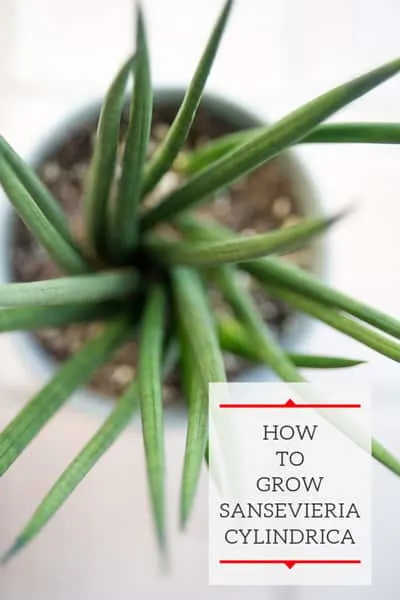
Table of Contents
About Sansevieria Cylindrica
I always like to take my cue from nature in order to give me clues on plant care, and this plant is no exception!
Sansevieria cylindrica is a succulent plant that is native to Angola. It is also known as African Spear plant.
The interesting part about Sansevieria cylindrica is that it has adapted to dry, arid regions by having cylindrically shaped leaves.
This reduces the surface area of the leaves and allows it to survive harsher and drier conditions. Versus some of the softer leaved Sansevieria with broader, strap-like leaves.
Mother nature knows best!
Sansevieria Cylindrica Growing Conditions
LIGHT
Often times, when you go to the store and buy a plant, the labels are very misleading. There is SOME truth to plant labels, but many times they are misleading!
Sanseveria cylindrica, like any Sansevieria, is most often sold as a “low light” plant. This doesn’t mean that they NEED low light. It just simply means that they tolerate it more than other plants that are not labeled that way.
In fact, Sansevieria actually do best when they have some direct sun! I have 3 of these plants…ok actually 4. I can’t seem to get enough of this genus of plants. They all get at least a little bit of direct sun everyday.
Of course when the sun is out in Northern Ohio… *sigh*
My point is, if you want a truly beautiful Sansevieria cylindrica, don’t put it in a dark corner. It may tolerate those conditions, but it will not thrive and will eventually decline.
Sansevieria are not the fastest growing plants. If you have them in darker conditions, they will grow even more slowly so keep that in mind.
WATERING
For all my succulents, including Sansevieria cylindrica and other varieties of Sansevieria, this is how I water them.
I like to thoroughly soak the whole pot. Don’t fall into the trap of just adding a little bit of water because it’s a succulent. I feel so passionately about proper watering that I wrote a blog post on watering myths!
Be sure to check it out because it is one of the most important aspects of plant care!
Normally I like to take them to a sink and soak the pot throughly and let everything drain away. These plants demand excellent drainage. Never let them sit in water!
Then at this point, I will hold off on watering until the soil is completely dry. And even then, you can wait! They were designed by nature to be able to withstand dry soil. But be nice to your succulents and don’t let them suffer!
FERTILIZER
I have to admit, although I would like to fertilize my Sansevieria cylindrica plants regularly, I sometimes get lazy!
But when I do fertilize, I do like to use a special fertilizer. For all my succulent (and one cactus) at home, I like to use the Schultz Cactus fertilizer.
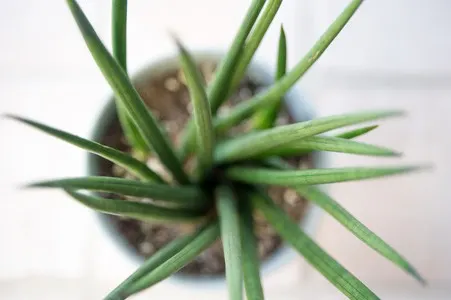
It uses a special low nitrogen formulation that succulents and cacti do best with. And it’s nice because you can use it every time you water! This is the way I prefer to water my houseplants. Dilutely with every watering.
This fertilizer is formulated that way. So you can fertilize with every watering.
If you forget to fertilize regularly, your plants won’t mind…but don’t completely ignore it. Just be sure to stop fertilizing during the winter months when your plant is not growing.
You don’t want to fertilize during the dreary parts of the year when plants are not growing.
SOIL BLENDS
I rarely will use any potting mix straight out of the bag anymore for any succulents or cactus. There are some good blends out there, but I like to tweak them a bit.
I like to start with either the Miracle Gro Cactus, Palm and Citrus mix or the Hoffman Cactus and Succulent mix.
To either of these mixes, for succulents like Sansevieria cylindrica, I like to add some 1/4″ pumice. You will be shocked at how much this will improve the drainage of your soil and provide more oxygen to your plant roots.
I like to use about 1 part pumice to 3 parts or so potting mix. You might end up finding your own ratio that works well for you, so don’t be afraid to experiment!
If you’re looking for an amazing potting mix that you can use straight out of the bag for your snake plant, check out the Tropical Succulent Soil Blend from Oh Happy Plants. This is an amazing mix and you will get 10% off at checkout automatically if you use my link.
REPOTTING SANSEVIERIA CYLINDRICA
If you have ever repotted a Sansevieria, you know that they can have some serious roots! The plants do like to be pot bound, but sometimes your plant will tell you when it needs to be repotted.
Sansevieria will often warp the pots that they are growing in. This is very apparent in plastic pots. But they have been known to break clay pots!
Take a look at the one below. This plant was just begging to be repotted!
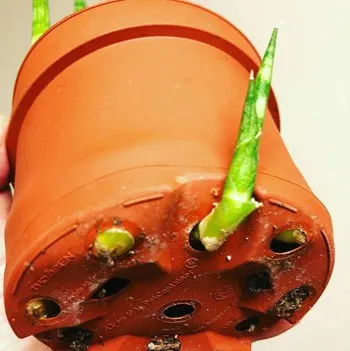
In this case, I had to take a pair of scissors and cut the plastic pot off in order to repot it.
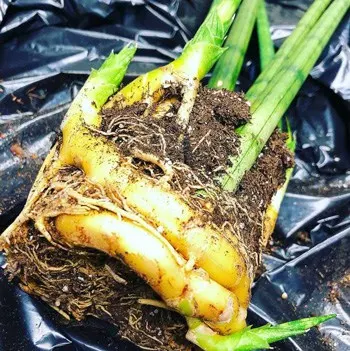
Look at those big fleshy roots! I decided to repot the plant into a terra cotta pot, and also separated one of the pups and gave it its own little pot. The pot might seem big for the pup, but there was a large piece of rhizome and I couldn’t fit it in a smaller pot.
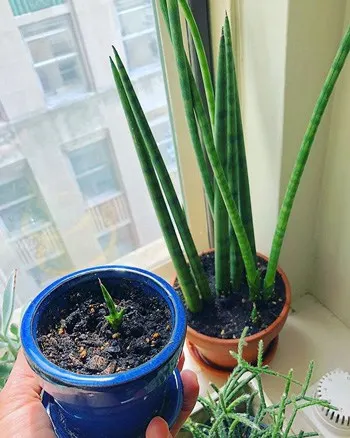
Normally when I repot a plant, I like to loosen the rootball. With Sansevieria, you just have to be a little more gentle because you don’t want to break the big fleshy roots.
Sansevieria Varieties
Sansevieria cylindrica is one of my absolute favorite Sansevieria varieties, but there are lots of other beautiful ones!
Take a look at the Sansevieria trifasciata Hahnii below. That plant is at least 15 years old! I have never divided it and I believe I’ve only repotted it twice during that time!
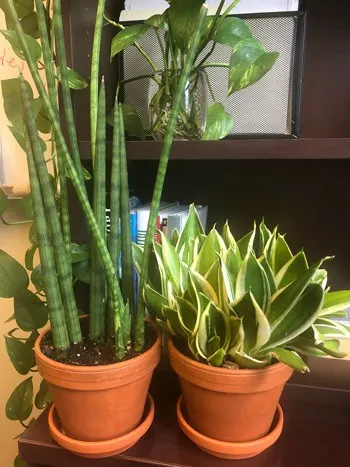
Another one of my favorites is the common Sansevieria laurentii with the beautiful yellow variegated edges. Isn’t it beautiful?
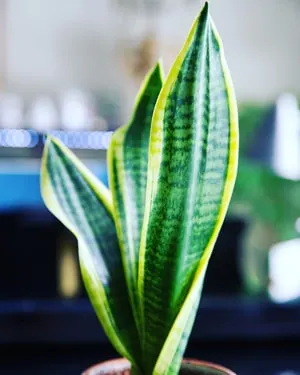
And last but not least, there are two more Sansevieria varieties that I love. I really love Sansevieria ‘Moonshine’ (pictured on the right below) A friend sent me this plant and it is putting out quite a few new leaves now.
The new leaves are a lighter color and darker a bit as they age. The form is more unusual for Sansevieria and I just love the shape and color of the leaves.
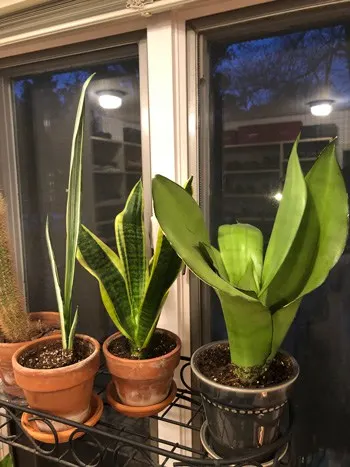
Last but not least, I really love Sansevieria Bantel’s Sensation, pictured on the left in the photo above. I’m looking forward to this one growing more leaves (this was also sent to me by a friend…I have some nice plant friends!) The skinny variegated leaves are stunning.
Of course there are many more varieties of Sansevieria than this, so go and grow a few! There are few houseplants that are as tough and forgiving as this amazing genus of plants. But beware! They can be addicting!
Be sure not to miss my post on 13 beautiful snake plant varieties that you can add to your collection.
How many Sansevieria do you have? Comment below…I’d love to hear from you!

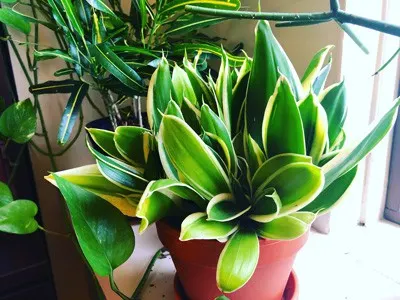

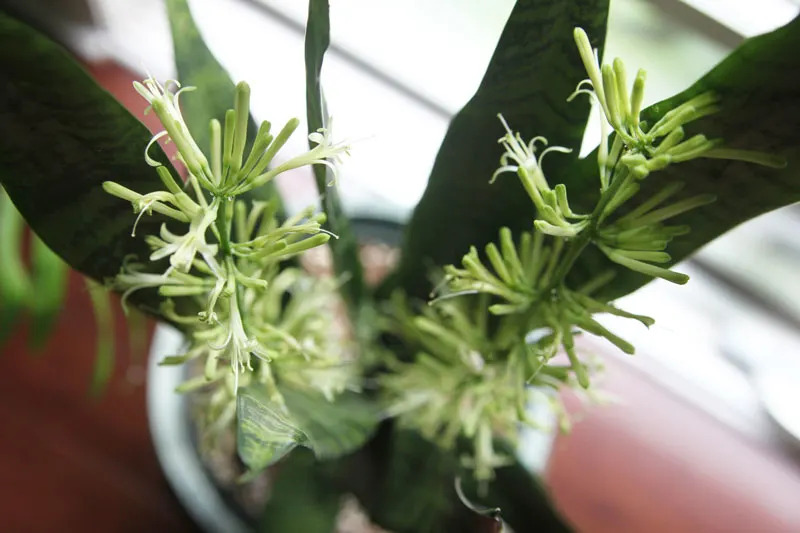
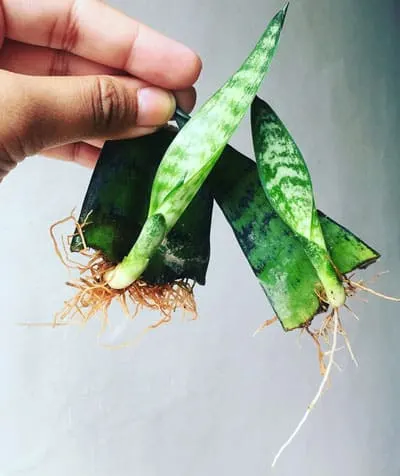
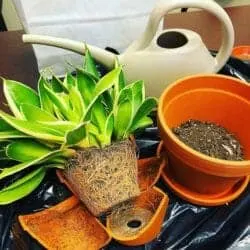
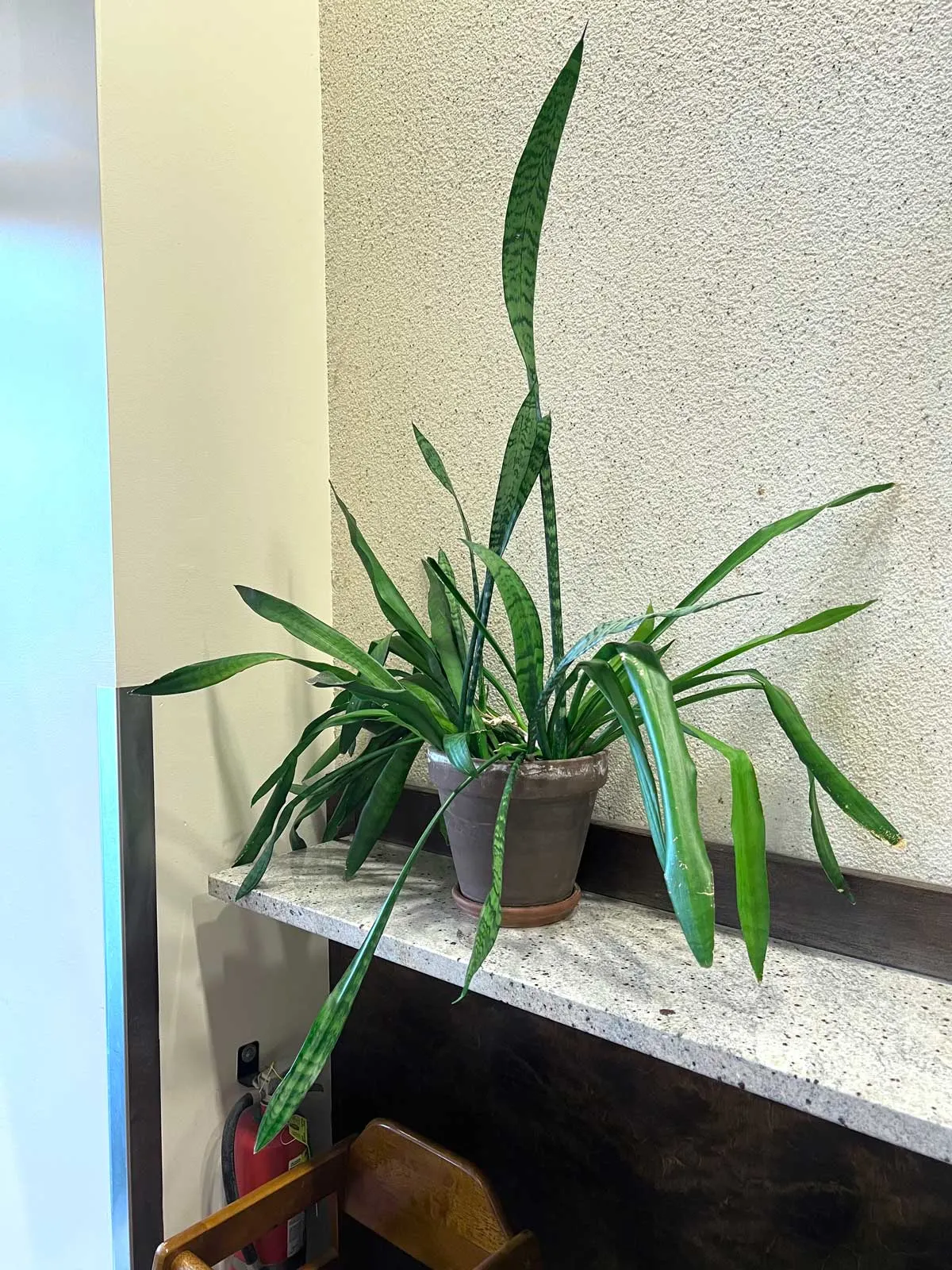
Steven
Friday 4th of November 2022
Very interesting post. I need an advice, I have one spear that is a lot taller than the others… It looks like, you know… male genitalia. I don’t want to cut it but even if I rotate it it continue to grow. Can you help me?
Raffaele
Friday 4th of November 2022
Haha. That's interesting. I don't think there is really anything you can do. Maybe give it a support stake if it starts to get floppy and lean over.
Victoria
Wednesday 3rd of August 2022
Hi! Thanks so much for this post! question I have had mine for about 19 years and the spears are getting to about 1 meter in height and are all falling over. is this normal due to the height? I am trying to find a way to get them to stand. It is really healthy and is still sprouting new growth with no brown spots at all. any suggestions would be great!
Raffaele
Thursday 4th of August 2022
Hi Victoria! Glad you enjoyed the post. You could try and increase the light to help make the plant sturdier if you'd like. That's really all I can think of. In the meantime, you can always add a stake or two in the pot and loosely tie them so they're not flopping around.
Dan
Sunday 31st of October 2021
Thanks for your very helpful posts. I have a few sanseveria cylindrica plants that have been divided. Every single sprout has opened, spreading leaves. Do you know a way to encourage it to grow “ cylindrical “ sprouts? Thanks, Dan
Raffaele
Sunday 31st of October 2021
Hi Dan, glad you enjoyed the post! They should turn more "cylindrical" over time. Just keep up your regular care and you should eventually get there. :-)
JoAnn
Sunday 5th of September 2021
My cylindrical sansevieria go out in all directions instead of staying upright, together, like yours. Any suggestions of what I can do? Thanks.
Raffaele
Saturday 11th of September 2021
Hi JoAnn! They will eventually get like that over time. Mine have gotten that way too where some are upright and some are leaning over. If you keep them in brighter light, they will stay stronger. You can place a stake in the pot and loosely tie them if you'd like to keep them more upright.
E.
Monday 23rd of August 2021
Hello! First, thanks for all the great blog posts. I find your plant blog to be one of the better ones. Your accounts of your real experiences with different aspects of plant care are so helpful!
I have 2 questions for you:
1. I often see sansevieria cylindrica sold in a braided form. Have you found this harmful for the plant in the long term? I plan on releasing mine from the binding as soon as I receive it, but I’m worried about the impact of the braiding on the plant’s longevity and health.
2. I noticed you stopped recommending coarse sand as a soil additive for plants that like sharply draining soil. Any reason for this?
Thanks again for a great blog!
Raffaele
Monday 23rd of August 2021
I'm glad you enjoy my site! As far as the braided Sansevieria, I don't think it's healthy for the leaves long-term, but I don't think it will kill your plant. If you unbraid them, it might look weird though but don't be afraid to experiment. As far as sand...There are many additives for potting mixes, and coarse sand is still good! You'll just have to see what you personally like to use and what also works for the plant. Cactus/succulent mixes usually have some mixed in already, and I like to add pumice to that as well. There really are many options so see what works best for you :-)